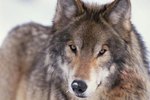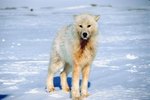
Earth has two tundra biomes: the Arctic, at the northern fringe of North America and Eurasia and on the Antarctic Peninsula, and the Alpine, found in high elevations around the globe. Both feature forbidding characteristics including frigid temperatures, treeless plains, short reproductive and growth seasons, minimal biodiversity and levels of permanently frozen subsoil. In these harsh environments, survival often depends on scavenging carrion -- either as a primary means of sustenance or as a supplement to hunting.
Canids
White to bluish-gray Arctic foxes -- and to a lesser degree, red foxes migrating onto the tundra as it becomes more hospitable due to climate change -- scavenge tundra plains. Foxes do hunt small prey, including birds and rodents, but seal remains from polar bear kills and other carcasses provide significant nourishment. Red foxes now compete with Arctic foxes for carrion, which may upset an already fragile ecosystem, though long-term effects still remain unclear. Arctic wolves, which feature thick coats of white to light gray, also scavenge tundra plains. For them, though, sustenance comes primarily from predatory behavior. Being larger than foxes and hunting in packs affords them more prey options, including deer, oxen, hares and other animals.
Wolverines
Although fierce predators when they need to be, wolverines frequently make use of scavenged carrion in Alpine tundra environments, especially during the scarce winter months. Wolverines look a bit like small bears but belong to the weasel family. Reindeer meat left over from lynx kills comprises a significant portion of the carrion scavenged by wolverines; sometimes, wolverines even chase off a lynx still enjoying the fruits of its hunt. Wolverines also enjoy finding carcasses of other large mammals, including elk, caribou and deer, but they can kill these creatures, too, when necessary. Most of their prey consists of smaller animals, such as rabbits and rodents; they also occasionally enter burrows to prey on hibernating animals.
Birds
Birds account for much of the tundra's relatively minimal biodiversity. All carnivorous birds in this biome scavenge, but many only to supplement what they can kill during food-scarce winter months; most subsist primarily on prey like fish, smaller birds, lemmings and other rodents. Ravens and gulls, two true scavengers, live in tundra environments, while famed scavengers such as vultures and crows do not. Predator birds, including gyrfalcons, snowy owls, thick-billed murres, dovekies and black guillemots, hunt for fresh food, but aren't above partaking from a polar bear or other animal's leftovers when necessary.
Ground Beetles
Among the few types of insects residing in tundra environments, many ground beetle species thrive; about 90 have been identified in the Eurasian tundra alone. Their dietary flexibility contributes to their ability to prosper around the globe and in harsh settings like the tundra. Carnivorous ground beetles prey on other insects and invertebrates and scavenge from carrion. The extent of their reliance on either food source depends on the beetle species and availability in their environment. Scavenging from carcasses takes on greater importance in places like the tundra, with its relatively limited supply of slugs, snails and insects to prey upon.
References
- University of California Museum of Paleontology: The Tundra Biome
- National Geographic: Tundra
- Edge of the Arctic Shelf: Arctic Wildlife
- Texas Natural Wildlife: Scavenging Birds
- Journal of Mammalogy: Influence of Intraguild Interactions on Resource Use by Wolverines and Eurasian Lynx
- National Geographic: Wolverine
- Entomological Review: Family of Ground Beetles (Coleoptera, Carabidae) in the Arctic Fauna
- Royal Entomological Society: Ground Beetles (Coleoptera)
Photo Credits
-
arctic fox image by Gail Johnson from Fotolia.com
Writer Bio
Eric Mohrman has been a freelance writer since 2007, focusing on travel, food and lifestyle stories. His creative writing is also widely published. He lives in Orlando, Florida.




